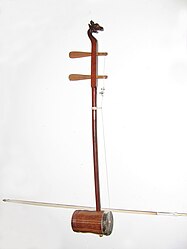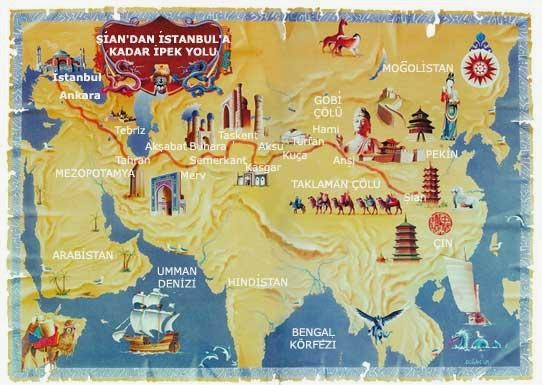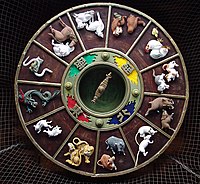By Levent Ağaoğlu, Hong Kong, October 29, 1998
Here I stand, watching the sun, which is about to rise from the East… Just as I witness the daybreak, I can also see from a distance, the awakening of the entire nations of the East. Their reawakening will undoubtedly be directed at progress and prosperity. Mustafa Kemal Ataturk, 1933 Founder of the Republic of Turkey
Last two decades of the 20th Century witnessed the reemergence of the once powerful worlds in history, Turkic World and Chinese World. It is deeply meaningful both for Turkey and China.
While we are today celebrating Turkey’s 75th anniversary of the founding of the Republic of Turkey, we will next year, celebrate with China, her 50th anniversary of the founding of the People’s Republic of China.
Although the two states are considered young in the republican forms, their ancestors used to play an important role in the history as close neighbors over the past millenniums in the Asia Continent.

The friendship of the two nations began when the old Turcoman Cavalry, raised from Central and Southern Asia Steppes, and entered into China history along the Yellow River valleys. A host of intermarriages, cultural, political and economic exchanges subsequently took place between the Turkic and Chinese civilization throughout the course of common history, spanning more than 3000 years.
Being people of today, perhaps we may try to see some cultural exchange that the two nations used to influence each other.
Chinese aesthetics were an important influence on Ottoman craftsmen, particularly in the creation of designs for the fledgling ceramics industry at Iznik. We can see today the effect from the Chinese Blue and White porcelain on the tiles used in the Topkapi Palace. In Turkish language, the word for China (çini) is the same as the word for porcelain.
In the middle of the 8th century, Chinese paper making technique was spread to Central Asia. This speeded up cultural exchange among the Turks. Thanks to Chinese paper, the Dictionary of Turkic language compiled in the eleventh century by the Turkish scholar Kasgarli Mahmut was able to survive until now.
Following the Turks and Chinese communication, the Turks used many Chinese words of everyday life. Until today, there are still some Chinese words being used popularly in modern Turkish life. For example, the pronunciation of tea (çay), china (çina), water (su), bed (tahta), cloth (ipek) and white cloth (bez), etc.
The Turkish-Chinese culture exchange also introduced fruits and food from China to Turkey. Orange was originated from the East; Chinese were the first in eliminating the bitterness of orange. Sweetened oranges were later brought to Portugal directly from China. Turks call orange as “Portakal” which clues from where this fruit first introduced to Turkey.
Mandarin also originated from China. “Mandarins” who were wearing yellow suits gave their name to this fruit, which is called as “Mandalina” by Turks.
Apricot was imported to Turkey from its very far away motherland – China. Succeeding military expedition of Alexander the Great, Apricot found its second motherland in Turkish city of Malatya. Now Turkey is the world leader of Apricot production.
Tea was introduced from China via Russia and other Middle East places. Prevalence of tea also stipulated imports of abundant Chinese porcelains into Ottoman Empire.
Chinese at the northern part eats Mantou, steamed bread. This is the origin of Turkish cuisine “Manti”.
Turkey is known for an abundance and diversity of foodstuff due to its rich flora, fauna and regional differentiation. And the legacy of an Imperial kitchen is inescapable. Hundreds of cooks specializing in different types of dishes, all eager to please the royal palace, no doubt had their influence in perfecting the cuisine, as we know it today.
The Turkish Cuisine has the extra privilege of being at the crossroads of the Far East and the Mediterranean, which mirrors a long and complex history of Turkish migration from the steppes of Central Asia (where they mingled with the Chinese) to Europe (where they exerted influence all the way to Vienna).
Turks had coins in Chinese style and learned silk, porcelain, ceramic, paper and valued arts from Chinese.
At some quite early time the twelve-fold division became associated with a cycle of animals, the ox, the sheep, dragon, pig and so on. There ahs been great debate among scholars, both Eastern and Western, about the origin of these associations some maintaining that the Chinese took them from neighboring Turkic peoples.

Origins of Huqin (Chinese violin) are unclear, however hu syllable implies that this instrument is related to Turco-Mongolian culture. Huqin entered into China in 13th century AD. Music, which is known as “Chinese” today, has a very deep roots in Central Asia mainly.
A type of Chinese dumpling is called Huntun because the Hun and Tun clans of the northern parts outside the Great Wall first made it.
Eastern symbolic patterns commonly found in Turkish art include the Chinese dragons (cinnamon in Turkish), which are two parallel wavy lines (duality) and three beads, the tree of life and the vine loaded with grapes (symbols of longevity and fertility, also found in Greek art), stylized flowers (hate), and yin yang (the Chinese female-male duality). The Turkish adaptation of yin yang at times appears as swaying cypress trees. Cinnamon appears as a talisman; the hate blossom is a lotus in profile.
Much of Turkish art comes originally from Central Asia or it’s connected with the Islam. Some of the designs of Turkish carpets are said to be Chinese.
It is curious that like several other things, inoculation appears to have been introduced into the West from China. It has been known and practiced in China since the time of Sung Dynasty about 800 years ago. It was first introduced into England by Lady Montague, the wife of the British Ambassador at Istanbul in 1721 BC, and doubtless had found its way to Turkey across the center of Asia from China. The Turks who lived on the Chinese frontier must have carried out the knowledge of it when they have moved westward.
The first documented proof of wines, rather than vines, come from 674AD, when a spectacular grape variety was sent to Emperor Tai Tsung by a Turkish people known as the yagbu.

For many centuries the manufacturer of silk had remained a closely guarded secret in China and the export of silkworms was punishable by death. In 552CE two Nestorian monks succeeded in smuggling silkworm eggs from China to Istanbul and by the early seventh century sericulture was well established in Asia Minor. Silk production has developed to excellent levels in the Turkish city of Bursa, one of the Ottoman Empire capitals. The basis of that development was an earlier tradition.
Glassmaking is essentially a skill born of and developed by the Western countries, namely Turkey. And until today, the Paşabahçe Glass, Turkey’s no. 1 glassware manufacturer, is still playing an important role in China country, continuing the duty for Turkey and China shake-hands.
CULTURAL EXCHANGES: TURKS AND CHINESE
ART :
TURKS Huqin
CHINESE Chinese dragons design (Çintamani)
LANGUAGE :
CHINESE Yin Yang design Bilingual Tablets Tea, China, Water, Bed, White Cloth, Cloth
CUISINE & FRUITS :
TURKS Mantau Huntun Grape Wine
CHINESE Tea Apricot Mandarin Orange
TRADE & MATERIALS :
TURKS Horses Cattle Hides Furs Ironware Cotton Cloth
CHINESE Silk Paper Grain Tea
OTHERS :
TURKS Twelve Fold division Zodiacs
CHINESE Inoculation Money Book Printing (Press)




















